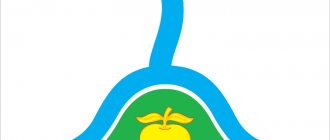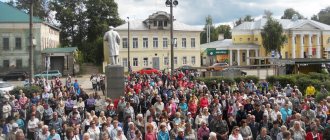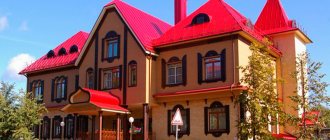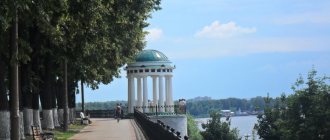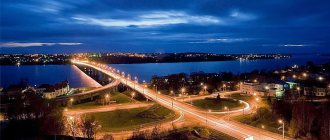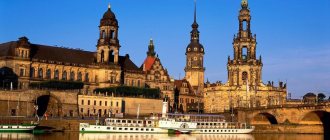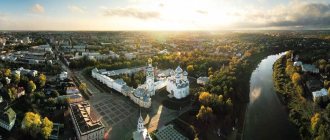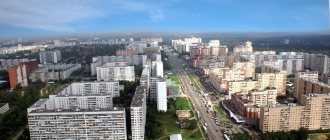The Rostov region is one of the southernmost in Russia. It borders on the Krasnodar Territory, Stavropol Territory, and Ukraine. Favorable climate, access to the sea, history and culture make the banks of the Don an attractive place to live.
The population density here is higher than in other parts of the country. The demographic dynamics in this land coincides with the picture throughout the post-Soviet space. But the Don region has its own specifics. History has given a unique national and religious palette to the cities and rural settlements of the Rostov region.
Dynamics
The number of residents living in the Rostov region has been declining over recent years.
Growth (largely due to incoming Russian-speaking citizens from post-Soviet countries) was observed at the end of the last decade of the last century. At the peak of the influx of people in 1997, the number of people living here was close to 4.5 million people.
Over two decades of the 21st century, natural decline amounted to 256,625 people. (from 4,454,446 in 2000 to 4,197,821 in 2022) or 5.7%. This process is associated with a decrease in the birth rate while maintaining the mortality rate. In 2022 5.5% fewer children were born than in the previous year.
The indicators of loss and outflow of people (and, as a consequence, a decrease in the total population) in industrial cities: Shakhty, Novoshakhtinsk, Kamensk-Shakhtinsky and others are critical. But compared to many constituent entities of the Russian Federation, the loss rate in the region is not so catastrophic. The region ranks 39th out of 85 in Russia, taking into account the positive and negative results of demographic processes. This is explained by the fact that 26% of the loss is compensated by the influx of migrants.
The efforts of the government and social structures of the Rostov region are aimed at improving demographics. In accordance with the federal program, it is planned to ensure an increase in the birth rate to 1.567 by 2024. In some settlements of the Rostov region in 2018-2020, it was possible to increase the number of newborn children (in particular, in Zverevo, Azov, Myasnikovsky, Sholokhovsky, Millerovsky, Tatsinsky, Tarasovsky districts).
Average life expectancy is 73.3 years.
Taganrog is the sea gate of the Rostov region
Taganrog has the status of an urban district. It is located on the coast of the Azov Sea. This is an important port; there is a Russian naval base here. The number of citizens is estimated at 250,000. The predecessor of Taganrog was the Italian port of Porto Pisano (13th century). Later, a fortress was founded on this site. Its favorable location made the port a center of maritime trade. Italian and Greek merchants flocked here. With the beginning of the development of industry in Taganrog, metallurgical and machine-building complexes and power plants began to be built.
Nowadays there are automobile, aircraft, ship repair, and manufacturing industries here. Enterprises and port docks provide work for the entire working population. Taganrog is also important as a transport hub. It is connected to other cities through rail, road, and air networks. The seaport carries out cargo transportation and cruises on the Black and Azov Seas.
Data by city
The largest municipalities of the Rostov region according to the permanent population are the following cities (data as of the beginning of 2022):
- Rostov-on-Don – 1,137,904 people.
- Taganrog – 248,643.
- Mines – 230,262.
- Volgodonsk – 168,035.
- Novocherkassk – 168,035.
- Bataysk – 127,919.
- Novoshakhtinsk – 106,534.
- Kamensk-Shakhtinsky – 87,760.
- Azov – 80,428.
- Gukovo – 63,150.
- Donetsk – 46,732.
- Morozovsk – 24,575.
- Zverevo – 19,726.
- Zimovniki – 18,070.
There is only one “millionaire” - Rostov-on-Don, it ranks 10th in Russia. The largest ones are Taganrog, Shakhty, Volgodonsk, Novocherkassk. The remaining cities are relatively small in terms of the number of permanent residents.
A number of municipalities can rather be classified as villages based on the number of people living in them, for example, the cities of Morozovsk, Zverevo, Zimovniki. Municipalities are gradually being consolidated through mergers with small settlements. Currently, the boundaries of such entities as Taganrog, Shakhty, Donetsk include nearby villages. In terms of quality of life, municipalities have a negative assessment based on population surveys. Even the capital of the area occupies only 29th place in the all-Russian ranking.
About a third of Rostovites live in the villages and hamlets of Bagaevsky, Belokalitvinsky, Bokovsky, Verkhnedonsky, Veselovsky, Egorlyksky, Zavetinsky, Kagalnitsky, Konstantinovsky, Krasnosulinsky, Kuibyshevsky, Martynovsky, Matveevo-Kurgansky, Millerovsky, Neklinovsky and other districts of the Rostov region.
Geography
| This section needs expansion . |
The borders of the Rostov region are Ukraine and Volgograd and the Voronezh region in the north, Krasnodar and the Stavropol Territory in the south, and the Republic of Kalmykia in the east. The Rostov region is located in the Pontic-Caspian steppe. It's due north over the North Caucasus.
This is within Russia's Southern Federal District.
Rivers and lakes
The Don River, one of Eurasia's largest rivers in Russia, partially flows through the region. Lakes occupy only 0.4% of the region's area.
National composition
In this area you can meet representatives of more than 40 ethnic groups. According to surveys, 90.3% consider themselves Russian. 2.64% are Armenians. Basically they are not migrants of the post-Soviet period. The Armenian diaspora appeared here several centuries ago. The community in Rostov-on-Don is especially close-knit. And in some cities of regional subordination, representatives of the Armenian ethnic group make up the majority in terms of population. The common border with Ukraine explains a fairly significant share (up to 4% according to population surveys) of Ukrainians.
2010 data
The territory is inhabited by Azerbaijanis, Turks, Gypsies, Moldovans, Germans, Jews, Tatars, Belarusians, Bashkirs, Poles, Greeks and representatives of Caucasian ethnic groups. These communities appeared in a number of cities and towns in the Rostov region in the 16th – 18th centuries. Diasporas celebrate holidays, there are national educational and cultural institutions.
The ethnic diversity of the Rostov region is reflected in the names. Examples include Nakhichevan-on-Don (now one of the districts of the regional center), Millerovo and other toponyms. The Don Cossacks are a special socio-ethnic community. According to various estimates, up to 30% of the total permanent population of the Rostov region consider themselves Cossacks.
Rostov-on-Don
Economy
The southern capital has not had trade relations with Turkish and Greek merchants for a long time, but this fact does not affect its economy in any way. Today the city is firmly on its feet and practically does not need third-party subsidies. The main income to the Rostov budget comes from local industrial enterprises, and this is not only the notorious Rostselmash, which awarded the city the title of “combine capital”. The basis of the local economy is made up of factories operating in the military-industrial complex (Almaz, Pribor, Horizon), agro-industrial groups (Yug Rusi), tobacco factories (ZAO Donskoy Tabak) and the famous clothing company Gloria Jeans "
Central market of Rostov-on-Don
Nature and ecology
Rostov-on-Don and its surroundings, satellite view
Rostov, without exaggeration, can be classified as one of the greenest cities in Russia, which is not entirely typical for the southern regions. The reason for this love of local residents for plants goes back to 1910 - it was then that the first tree planting festival was held in Rostov.
In the early 2000s, the tradition was revived: now the solemn ceremony of planting trees and ornamental shrubs is held twice a year. Such measures have not yet had any effect on the cleanliness of Rostov air: there are too many industrial enterprises and vehicles here. However, the leadership of the “southern capital” is already seriously thinking about moving some factories outside the city limits.
What there are no problems with in Rostov is water. In addition to the Don, two more rivers flow through the city - Dead Donets and Temernik. There are lakes on its territory, and even its own “sea”, which is an artificially created reservoir. However, if they wish, Rostovites can afford to swim in the real sea: the distance from here to Azov is only a few tens of kilometers.
City districts
Rostov-on-Don is divided into five districts:
- Voroshilovsky;
- Railway;
- Kirovsky;
- Leninist;
- October;
- Pervomaisky;
- Proletarian;
- Soviet.
In recent years, the city has been actively developing, so that in the foreseeable future the “southern capital” will have three more districts. As for the existing ones, they all have their own flavor, although they are unequal in terms of attractions.
Rostov-on-Don
From the point of view of a tourist who comes to Rostov on an excursion, Kirovsky may seem the most interesting. Zheleznodorozhny and Oktyabrsky districts. In search of architectural monuments, it is better to go to Kirovsky, where the historical center of the city used to be located. To look into the largest Botanical Garden in Russia and appreciate the cool alleys of the Kumzhinskaya Grove, you will have to take a ride to the Zheleznodorozhny district. All historical mansions and apartment buildings are located in the Leninsky district, and the Rostov Zoo and green squares are in Oktyabrsky.
To take a break from the frantic pace of city life and breathe clean air, it is better to go to Levberdon - a picturesque section of the left bank of the Don, which includes parts of the Leninsky and Kirovsky districts. The hallmark of this part of Rostov is sandy beaches, shady parks, recreation areas and numerous recreation centers.
Roofs of the old city
Yard-well of an old house
Sights, entertainment, interesting places
If you set aside at least 15 minutes to explore each Rostov attraction, it will take several days to get to know them. So those who are in the city for a very limited period of time are advised to take a walk along the most famous streets and places. It’s better to start from Bolshaya Sadovaya Street, which began to be built up in 1781. It is here that most of the architectural monuments of the “southern capital” are located, including a luxurious mansion given to actress Margarita Chernova by one of her admirers.
City embankment. Singing fountain "Petrovsky"
Walking around Rostov, it is difficult to ignore Teatralnaya Square, the location of the main city fountain - “Atlanta”. The attitude of the old-timers towards the sculptural group is slightly skeptical, which is understandable: they say that the titans were modeled after local bureaucrats.
Theater Square in Rostov-on-Don
Rostov Regional Youth Academic Theater
Academic Drama Theater named after M. Gorky
The embankment of the Don River continues to occupy the first place in terms of attendance, where most dates are arranged and all folk festivities take place. What is noteworthy: one of the most beautiful and well-maintained streets of the city was built in the middle of the 19th century. by convicts and prisoners.
Embankment of Rostov-on-Don
The best place to organize a small picnic or just a leisurely walk is Kumzhenskaya Grove. A cozy and well-maintained park is surrounded by two rivers – the Don and the Dead Donets. Having studied the routes of the local alleys and found the most beautiful clearings, stand for a few minutes at the Kumzhensky memorial, which includes a monument to the soldiers who died for the liberation of Rostov and a mass grave.
Rostov Zoo
If you come with children and don’t know what to do with them, go to the local zoo, where more than 400 species of animals live in comfortable enclosures. Well, after you get to know all the inhabitants of this establishment, buy tickets to the water show at the Rostov Dolphinarium. Rumor has it that the performances here are simply fabulous.
The land of Rostov is also happy for pilgrims. You can venerate Orthodox shrines in the Church of Seraphim of Sarov, built at the beginning of the 20th century. To pray at the icon of the Iveron Mother of God, it is worth visiting the Holy Iveron Monastery. The Church of the Intercession, which is essentially a new building built with donations from believers, is also worthy of attention. And of course, you cannot pass by the main church of the Rostov diocese - the Cathedral of the Nativity of the Blessed Virgin Mary.
A fantastic spectacle awaits city guests at the Paramonovsky warehouses, which today represent picturesque ruins from which the purest underground springs flow. In its best times, Paramonov’s warehouses were the main Rostov granary, and at the same time a place of work for thousands of citizens. By the way, Alexey Peshkov (Maxim Gorky) worked here for some time.
Paramonovsky warehouses
Only in Rostov can the most seemingly ordinary object, like a toilet on Gazetny, become a landmark. This building once housed a bohemian cafe where local poets came to hang out. And during the Great Patriotic War, German officers relaxed here over a glass of schnapps. The cafe became a public place in 1945. Today, the toilet on Gazetny was bought by a local moneybag, and its premises are being renovated. Who knows, maybe soon the building will once again turn into a stylish cafe for the creative elite.
The Rostov Museum of Fine Arts is a place that should be visited by anyone who believes that true masterpieces of world painting can be found exclusively in European galleries. The museum exhibits works by both domestic masters (Repin, Surikov, Bryullov) and paintings by foreign artists (Rubens, de Troyes, Carpioni, Pretty). Well, those who are partial to everything related to space should set aside time for the museum exhibition on Stachki Avenue. Here guests will be shown the personal belongings of the astronauts, and even sent on a virtual flight to the stars.
Monuments and sculptures
The monuments of Rostov are not classic monuments to leaders and busts of famous countrymen (although they are there too), but literary characters, funny representatives of all kinds of professions, and, of course, Father Don himself. Most often, the heroes of Sholokhov’s works are “cast in metal”. For example, on the city embankment, the bronze grandfather Shchukar cooks meat soup in a pot, simultaneously teaching his invisible interlocutor the basics of farming. Here you can also find one of the unofficial symbols of the city - the sculpture “Rostovchanka”. Not far from the river station, Grigory and Aksinya are sailing towards their happiness, and at the central registry office, the freckled Nakhalenok is racing at full speed from an angry goose. The same character, only now straddling the fence, adorns the Don embankment.
Monument "Rostovchanka"
Sculpture "Gregory and Aksinya in a boat"
Monument to Nakhalyonok
Monument "Tachanka"
Monument to Mikhail Sholokhov
In Pokrovsky Square there is a monument to the water supply system - a slender Cossack woman with a bucket at the pump. And near Gorky Park, a bronze flower girl stood on the sidewalk with her seasonal wares. Here a colorful peddler “walks” with a cat who grants wishes. To implement your plan, you just need to grab the merchant by the floor, throw a ruble into the box and pet his furry companion. In the park on the street. Workers can hug a pot-bellied brewer, and at the public library, take a photo in front of a book bed.
Armenian Church of Surb-Khach (Holy Cross), the oldest building in the city (late 18th century)
Fans of the creativity of the “sun of Russian poetry” are recommended to take a walk to the intersection of the street. Pushkinskaya and lane. Semashko, where majestic lions rest, holding characters from Pushkin’s fairy tales in their paws. You can see the “Industrial Heart of the Don” and the “Mechanical Harmonist” on the city embankment. There is also a sculpture dedicated to the main Don delicacy - boiled crayfish.
An unusual composition greets tourists at the intersection of Stachki Avenue and st. International. A snow-white palm, from the center of which a small living tree grows, symbolizes humanity’s responsibility to nature. The sculpture is called “Tree of Life”.
Holidays
Twice a year, residents of Rostov remember the environmental situation in the city and, armed with shovels, go to celebrate Arbor Day. So, if at this moment you find yourself in the “southern capital”, do not shy away from your responsibility to future generations and do your part in greening the planet.
Since 1995, every autumn the festival “Friendly Family of the Peoples of the Don” has been organized in Rostov. Any guest of the city can join the mass festivities.
Every third Sunday in September, a special excitement reigns in the center of the Southern Federal District - Rostov celebrates City Day. The holiday is celebrated on a southern scale, which attracts tourists.
Rostov-on-Don City Day
Transport
The million-plus city has almost all types of public transport. The most common option is buses; you can use them to get anywhere in Rostov. If you plan to travel within the central part of the city, you can try taking a tram ride. There are only four trolleybus routes in the regional center. You can pay for your trip in cash or by card, but the latter option is somewhat more economical. You can buy a “transport pass” in special terminals scattered at bus stops and underground passages.
Evening Rostov
Despite the relative diversity of means of transportation, rush hours in Rostov, as in most large cities, have not been cancelled. So sometimes calling a taxi will help save not only time, but also nerves. For lovers of leisurely excursions along the water surface, there are local motor ships. All of them depart from the piers of the Central Embankment. There are also bicycle rental points here, where for a fairly reasonable amount you can get a two-wheeled friend who is not afraid of city traffic jams.
If necessary, you can rent a car (there are offices of several large rental companies in Rostov). This will not make you move around the city any faster - in terms of traffic jams, the “southern capital” is not much different from the mother capital. But the car can be useful for traveling around the region and surrounding areas.
Panorama of Rostov-on-Don
Where to stay
Accommodation in Rostov is not a problem; the main thing is to initially decide on the amount that seems most optimal to you. If you want to stroke your own ego, welcome to five-star hotels and residences (“Vizvolte”, “Petrovsky Prichal”), the average price per room in which starts from 7,000 rubles.
You can also find a decent room from those with three stars (“Jardine”, “House of Artist”, “Don Quixote”, “Byron”). The prices here are very different: from quite affordable (1,700 rubles for a double room) to those approaching the level of higher-class hotels (4,000 rubles).
With a limited budget, it’s easier to limit yourself to a bed in some cozy hostel. There are plenty of establishments of this type in the “southern capital”, but everyone has a different reputation. Relatively good options, according to reviews from tourists, are “Baba Valya”, “Oliver”, “Teremok”, “Respublika”, etc. On average, an overnight stay in a hostel will cost from 300 to 500 rubles.
Booking.com
Restaurants and cafes
Left Bank of the Don
In a multinational city, the cuisine is multinational, so along with traditional European-style restaurants, you can also find places with a distinct Caucasian or Asian flavor. And of course, since you have come to the homeland of Mikhail Sholokhov, do not miss the opportunity to sit in the “Cossack Kuren”, “Ataman Estate” or “Collective Farm”. In addition to authentic interiors, these establishments have another significant advantage - they adhere to old traditions and prepare traditional Don dishes.
Be sure to try the fish soup at the restaurant of the same name on Teatralnaya Square (it is cooked here from several varieties of fish), taste the Don crayfish prepared according to an old Cossack recipe, and have a dessert common in these places - sweet kaymak.
You can indulge in local smoked fish, pike caviar and real Don borscht at the Rostov-Papa restaurant. And for those who can’t imagine their life without fast food, we can recommend the Rostov chain of eateries “Zolotoy Kolos”, cafe “Zhadina Burgers” and “Side by Side”. The most delicious beer is served in the Yesenin craft pub, and the best Belgian waffles are usually ordered at Too Good For Food.
You definitely haven’t been to Rostov if...
- we didn’t take a walk along “Rostov Broadway” - the most beautiful section of Bolshaya Sadovaya, running from Buddenovsky Prospekt to Voroshilovsky;
- didn’t take a photo at the monument to the combine harvester;
- didn’t try salted watermelon in Rostov style;
- they did not bring with them a faience figurine or a cup from the Semikarakorsk Aksinya factory;
- We did not taste the herbal Don tincture produced by a local winery.
- didn’t buy a real Cossack whip or at least a refrigerator magnet with Cossack symbols;
- We didn’t stock up on a bunch of dried Don bream.
How to get there
Rostov-on-Don
By plane from Moscow (Vnukovo, Sheremetyevo, Domodedovo airports). Flights operate daily, travel time is around 2 hours.
By train. The vast majority of trains in the southern direction pass through Rostov (Adler, Anapa, Kislovodsk, Novorossiysk, etc.) The trip takes on average from 16 to 18 hours.
By bus. Flights can be both direct and transit. Departure from the Kazansky railway station, Krasnogvardeyskaya and Varshavskaya bus stations, as well as from the Yuzhnye Vorota station. Duration of the route is 16-18 hours.
By car. The path passes through the M4 Don highway. In several regions (Moscow, Voronezh, Lipetsk) there are paid sections.
Calendar of low prices for air tickets
Religions
There are up to 500 religious organizations of 33 faiths operating here. The majority consider themselves Orthodox Christians or atheists. But there are also numerous parishes of the Armenian Apostolic, Lutheran, Baptist, Catholic, Protestant churches, there are Muslim and Jewish communities, organizations of evangelists and Adventists.
A large number of religious monuments have been preserved in the region. On the map of attractions of the Rostov region you can easily find real masterpieces of religious architecture. These are such pearls as the Ascension Military Cathedral in Novocherkassk, the Soldiers' Synagogue and the Armenian Church of Surb Khach, the temples of the Sovereign Icon of the Mother of God in the center of Donetsk and St. Nicholas the Wonderworker in the village of Nikolaevka, Neklinovsky district, Rostov region and many others. Recently, several mosques have been built.
F. G. Ranevskaya
| Ranevskaya Faina Grigorievna (1896-1984), Russian actress, People's Artist of the USSR (1961). On stage since 1915. In 1949-55 and from 1963 at the Moscow Theater. Mossovet. A brilliant character actress with a penchant for eccentricity and the grotesque; the merciless sobriety of her outlook on life was softened by wise irony, the images acquired dramatic and even tragic depth: Birdie (“Little Chanterelles” by L. Helman, 1945), Speculator (“Storm” by V. N. Bill-Belotserkovsky, 1951), Lucy Cooper (“ Further - silence" V. Delmar, 1969), Felitsata ("Truth is good, but happiness is better" by A. N. Ostrovsky, 1980), etc. She acted in films (films: "Foundling", 1940; "Dream", 1943 ; “Wedding”, 1944, etc.). USSR State Prize (1949, 1951). |
Marriages and divorces
Detailed official statistics on registration and divorce of marriages suggest that the picture reflects nationwide trends. The number of newly created families for 2022 is 20,935, which is 20% less than in the previous period.
79% of registered marriages are dissolved. The number of divorces in 2020 decreased by 8%, but remains critical. Divorce statistics in cities are worse than in rural areas. The age of people getting married is growing, young people prefer informal relationships.
Economy
Main industries : mechanical engineering (JSC Krasny Kotelshchik, Pressmash; combine harvester, ship repair plants); instrument making (PO "Vibropribor", factories: commercial equipment, electrothermal equipment, "Pribor"); ferrous metallurgy (OJSC Taganrog Metallurgical Plant - production of steel, rolled sheets, pipes for the oil and gas industry); chemical (paint and varnish), light (including leather and footwear), food and flavoring (fish processing plant, meat, confectionery, flour and cereal factories).
Migration
In 2022, the Rostov region experienced an increase in migration. Its main source is the independent movement of residents from other parts of Russia. 73% of those newly settled in the region are citizens of the Russian Federation from other regions. 13% come from visitors from the CIS countries. The rest are migrants from far abroad.
But there is also an outflow of people from the region. Rostovites leave for Moscow, Kaliningrad region, Krasnodar region, St. Petersburg and abroad. The working population and students migrate. Young people are actively leaving industrial cities in the Rostov region, such as Shakhty, Donetsk, Novoshakhtinsk and others.
Given the presence of local specifics, trends on the banks of the Don coincide with all-Russian ones. Although the favorable climate makes the area attractive for internal migration, the number of arrivals cannot compensate for the loss of people. In recent years, Crimea has competed in terms of attractiveness for Russian migration. We can expect that the flow of people moving to the Rostov region will decrease. The indicators will worsen.
Taganrog
Coat of arms of Taganrog
The coat of arms of Taganrog was approved on April 15, 1808 and again adopted on February 25, 1994 and in 2002. The shield is divided into four parts. The first silver field has two azure (blue) horizontal stripes; in a purple field is the monogram of Peter I and the date of the founding of the city; in an azure (blue) field there is a silver sturgeon; in the fourth silver field there is a golden caduceus on top of two gold river anchors (with two claws) placed crosswise. In the golden field of the heart shield there is a scarlet cross.



